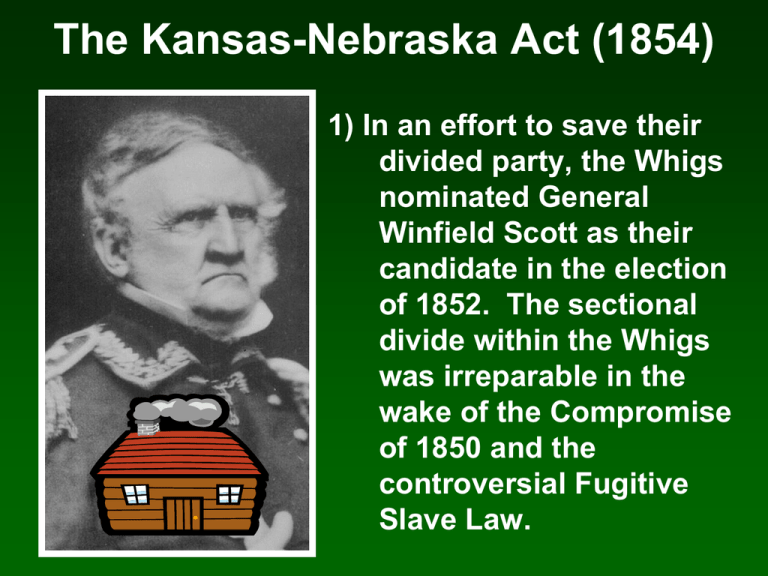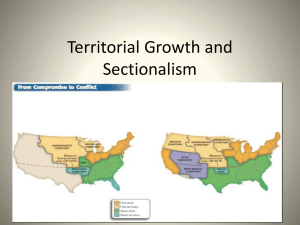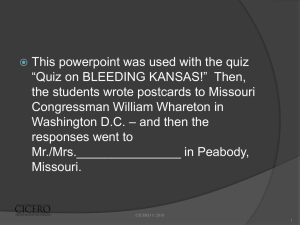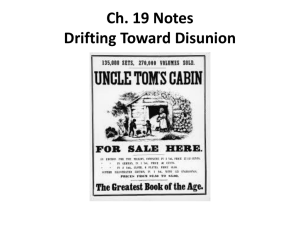File
advertisement

The Kansas-Nebraska Act (1854) 1) In an effort to save their divided party, the Whigs nominated General Winfield Scott as their candidate in the election of 1852. The sectional divide within the Whigs was irreparable in the wake of the Compromise of 1850 and the controversial Fugitive Slave Law. The Kansas-Nebraska Act (1854) 2) The Democrats nominated the obscure Franklin Pierce of New Hampshire in the hopes of preventing a similar political divide. Pierce’s northern roots and his support of southern slavery and the Compromise of 1850 appeased the sectional factions within the Democratic Party. The solidarity of the Democrats helped give Pierce a landslide victory over Winfield Scott and the divided Whigs. The Kansas-Nebraska Act (1854) Millard Fillmore Zachary Taylor Franklin Pierce 3) Similar to the Taylor and Fillmore administrations, Franklin Pierce provided little leadership on critical national issues like slavery, sectionalism, and states’ rights. Pierce’s foolish support of the Kansas-Nebraska Act caused the repeal of the Missouri Compromise and the explosion of sectional warfare in the West. The Kansas-Nebraska Act (1854) 4) With a sectional battle over a transcontinental railroad raging in Congress, Senator Stephen A. Douglas crafted a delicate legislative scheme to open new western territory to slavery in order to establish a northern railroad through his home state of Illinois. The Kansas-Nebraska Act (1854) 5) In exchange for the northern railroad, Douglass proposed that the vast Nebraska Territory would be divided into two separate territories – Kansas and Nebraska. Both territories would decide slavery through the democratic process of “popular sovereignty.” Many expansionist southerners were excited by the possibility that slavery could spread into western territories. The Kansas-Nebraska Act (1854) 6) Most southerners assumed that Kansas would likely vote to become a new slave state after settlers from slaveholding Missouri crossed over border. Nebraska’s border with free-soil Iowa ensured that it would remain free despite the prospect of “popular sovereignty.” The Kansas-Nebraska Act (1854) 7) The Kansas-Nebraska Act dangerously reopened the freesoil debate concerning the western territories. The new legislation not only disrupted the delicate peace established by the Compromise of 1850, it also forced the repeal of the Missouri Compromise of 1820 because both Kansas and Nebraska were north of the 36*30’ line of latitude. The Kansas-Nebraska Act (1854) 9) Former northern Whigs, Free-Soilers, and disillusioned northern Democrats formed the Republican Party in protest of the KansasNebraska Act. With most Democratic support coming from the South, the political parties now represented purely sectional interests. Bleeding Kansas (1855) 1) Many Southerners assumed that the Kansas territory would be voted a slave state through the process of “popular sovereignty.” To ensure the issue, Missouri Senator David Rice Atchison personally led groups of pro-slavery Missourians across the border to settle Kansas. They soon established the towns of Atchison, Shawnee Mission and Lecompton, Kansas. Bleeding Kansas (1855) 2) The pro-slavery settlers of Kansas were soon troubled by the presence of free-soil pioneers from northern states like Ohio, Iowa, and Illinois. Southerners feared that a free-soil Kansas would threaten the future of slavery and would prevent it from spreading to other western territories. Violent skirmishes between pro-slavery and free-soil settlers captured national attention and intensified the race to establish rival settlements. Bleeding Kansas (1855) 3) A pro-slavery South Carolinian that led an armed force of southern settlers to Kansas wrote, “Kansas is….the turning-point in the destinies of slavery and abolitionism. If the South triumphs, abolitionism will be defeated and shorn of its power for all time….If the North secures Kansas, the power of the South in Congress will be gradually diminished, and the slave population will become valueless. All depends on the action of the present moment.” Bleeding Kansas (1855) 5) Two thousands free soil settlers also moved into the territory. Reverend Henry Ward Beecher generated funds to purchase hundreds of new breech-loading Sharps rifles for the free-state settlers. The rifles later became known as “Beecher’s Bibles” because they were secretly sent to Kansas in wooden crates labeled “bibles.” Bleeding Kansas (1855) 9) Violent mobs of pro-slavery “Border Ruffians” from Missouri soon flooded the polls in Kansas and cast thousands of fraudulent votes. Missourians cast close to 80% of the 6,307 votes to elect a Kansas state legislature in March 1855. Despite considerable free-soil settlement, 39 of the 40 representatives elected to the state legislature were proslavery. Bleeding Kansas (1855) 10) The new government was established at Shawnee Mission, a proslavery settlement near the Missouri border. The new state legislature soon passed a number of strict laws aimed at suppressing abolitionism. Anti-slavery societies were banned and it became a felony to even speak out publicly against slavery. Bleeding Kansas (1855) 13) Violent outbreaks between pro-slavery and free-state settlers steadily escalated in Kansas through the fall of 1855. The mounting battle in Kansas convinced John Brown to delay the raid on Harpers Ferry in favor of joining his sons in Kansas. The Sack of Lawrence 4) In April 1856, pro-slavery Sheriff Samuel Jones was shot after he issued several bogus arrest warrants against free-state leaders in Lawrence, Kansas. Although Jones was only wounded, the proslavery press spread news of his murder and encouraged an attack on Lawrence, the freestate capital. The Sack of Lawrence 5) On May 21st, Senator David Atchison and Sheriff Samuel Jones led pro-slavery forces on a violent rampage known as the “Sack of Lawrence.” Homes were looted, newspaper presses were destroyed, and the free-state hotel was burned. Bleeding Congress 1) While the fighting raged on in Kansas, Abolitionist Senator Charles Sumner delivered an enraged speech in the Senate chambers on the “Crime Against Kansas.” With little concern for caution, he condemned the pro-slavery settlers as the “hirelings picked from the drunken spew and vomit of an uneasy civilization.” Bleeding Congress 2) Sumner’s assault on slavery included several personal attacks against supporters of the Kansas-Nebraska Act like Stephen A. Douglas of Illinois and Andrew Butler of South Carolina. Sumner railed against Douglas as a "noisome, squat, and nameless animal...not a proper model for an American senator." Sumner accused Butler of senility and even ridiculed the elderly Senator’s slurred speech and physical impairments that were the result of a stroke. Bleeding Congress 3) Two days passed and Butler’s nephew Preston Brooks, a Congressman from South Carolina, quietly entered the Senate chambers, approached Sumner’s desk, and viciously beat him with a cane. Sumner suffered severe trauma to the head and his injuries prevented him from resuming his Senate seat for over three years. Bleeding Congress 5) On May 22nd, the day after the Sack of Lawrence, news of Sumner’s beating reached John Brown and his men. Jason Brown recalled the reaction in camp, “At that blow the men went crazy – crazy. It seemed to be the finishing, decisive touch.” John Brown declared, “It was time to fight fire with fire” to “strike terror in the hearts of the pro-slavery people.” John Brown and Bleeding Kansas Pottawatomie Creek Massacre 1) Late on May 24th, John Brown led two followers and four of his own sons (Frederick, Salmon, Oliver, and Owen) to brutally kill five pro-slavery settlers living on Pottawatomie Creek. Brown’s victims were taken from their homes and were hacked to death with broad swords wielded by his sons and followers. Brown claimed that he supervised the killings, but he fired a bullet in a severely wounded victim to ensure his death. Pottawatomie Creek Massacre 4) The Pottawatomie Creek massacre led to an eruption of violence on both sides in Kansas. Anarchy reigned in Kansas as several bloody skirmishes flared throughout the territory. A newspaper editor described a “reign of terror” with “almost daily murders.” Pottawatomie Creek Massacre 5) Pottawatomie Creek was particularly shocking to southerners because they were accustomed to weak-kneed abolitionists and free-soil settlers that shunned violence. John Brown represented a new militant form of abolitionism that was willing to bring war against slavery. John Brown’s Raid 3) The legend of John Brown steadily grew from his involvement in Kansas following the murders on Pottawatomie Creek. Brown earned national attention when he led 38 free-state men to defend the free-state town of Osawatomie against an attack from over 300 Missourians. Brown’s brave actions earned him a national reputation as the “militant abolitionist” that would fight pro-slavery forces. John Brown’s Raid 4) Following the Battle of Osawatomie, John Brown Jr. wrote to his father, “The Battle of Osawatomie…has proved most unmistakably that “Yankees” WILL “fight.” Everyone I hear speaking of you is loud in your praise. The Missourians in this region show signs of great fear.” Planning Harpers Ferry 3) In order to stage his fight, Brown chose Harpers Ferry because it was situated within the protective shield of the Appalachian Mountains. The small town was also home to a federal arsenal and a commercial rifle factory. Brown believed that when his men occupied the town, the surrounding slaves would rise up and join his forces at the armory. Planning Harpers Ferry 1) While on his fundraising tour through New England, Brown used his donations to order the construction of one thousand pikes (a double edged Bowie knife attached to a six-foot pole) for his anti-slavery crusade. Harpers Ferry As the raid proved to be futile against the oncoming federal troops, John Brown looked for no surrender. He would have been killed within the federal armory at the town had it not been for the General catching his belt buckle on a sword thrust and then be having to beat him with the blunt of the sword. The Trial .. 1) Despite Brown’s defiance and his objection to a trial, the Charlestown court appointed him two local attorneys for his defense. They tried to argue that Brown was not guilty for reasons of insanity and they presented evidence that many of Brown’s relatives were mentally deranged. Brown strongly objected, “If I am insane, of course, I should think I know more than all the rest of the world. But I do not think so. The Trial 2) The jury only took forty-five minutes to find Brown guilty on all three counts. Brown was given an opportunity to address the court the following day when it reconvened for his sentencing. His address was heavily covered in the press and it generated northern sympathy for the righteousness of his cause years later. Southern Reactions 1) Shortly after John Brown’s capture in the fire-engine house, J.E.B. Stuart led a detachment of Marines to Kennedy farm in Maryland and seized a trunk of incriminating documents. Brown’s provisional constitution and his detailed maps revealed that his raid on Harpers Ferry would have been followed by an invasion deep into the slaveholding South. Southerners were horrified by the discovery of hundreds of pistols, rifles, knives, and pikes that would have been employed in such an insurrection. Southern Reactions 2) The discovery of Brown’s letters revealed the identities of his northern supporters. Letters from the “Secret Six” were reprinted in national newspapers and Brown’s associations with notable abolitionists like Frederick Douglass sent a wave of paranoia throughout the South. Brown no longer seemed like a delusional fanatic and Southerners became convinced that the Harpers Ferry Raid was the product of a massive conspiracy among powerful Northern politicians. Southern Reactions 7) Southern paranoia led several states to reorganize their militias in order to defend against the next invasion from the North. This military response in the South laid the foundation for the Confederate Army that was organized after several southern states seceded from the Union in 1860-61. Execution 11) John Brown only last words were scribbled in a short prophetic note that he handed to a guard outside his jail cell. It read, “I John Brown am now quite certain that the crimes of this guilty land: will never be purged away; but with Blood. I had as I now think; vainly flattered myself that without verry much bloodshed ; it might be done.” Brown correctly predicted that the emancipation of slavery would not occur without war. `









